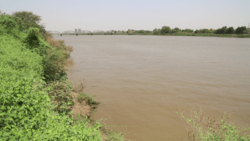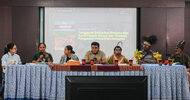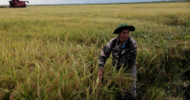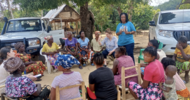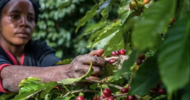Pulitzer Center | 30 May 2019
Land grabbing and its implications for Sudanese – Views from a scholar
Land grabbing and its implications for Sudanese – Views from a scholar
by FREDRICK MUGIRA and ANNIKA MCGINNIS
Investors from largely food-insecure Gulf countries are increasingly buying vast swaths of fertile land irrigated by the Nile River in Sudan to grow food crops to sustain their populations.
The Land Matrix database, which compiles data on land grabs from governments, companies, NGOs, the media and citizen contributions, has tracked 762,208 hectares of large-scale land acquisitions in Sudan since 1972, with most deals concluded after year 2000.
Most of this land was allocated to 28 transnational deals, with companies from mainly Middle Eastern states – including Qatar, Egypt, Lebanon, Kuwait, Saudia Arabia, the UAE and Syria – acquiring huge areas of land to produce food crops, animal feed such as alfalfa, and biofuels.
Investors from countries including Jordan, Turkey, Egypt, the UAE, and Saudi Arabia are also vying for another 3.4 million hectares of land, which are under negotiation.
Such foreign acquisitions are often referred to as ‘land grabs,’ since they consume large quantities of natural resources such as land and water often without regard for the local communities that relied upon the land.
To find out more, InfoNile cofounders Annika McGinnis and Fredrick Mugira talked to Stefano Turrini, a scholar involved in the study of land grabs and agricultural development in Sudanese drylands and a PhD candidate in Geography at Padova University in Italy.
They began by asking him to cite areas in Sudan that have experienced land and water grabbing most.
Stefano: Land and water grabbing in Sudan are mainly visible in the state of Khartoum, River Nile and Northern.
InfoNile: Why these regions in particular?
Stefano: Since the 2000s, these states of Sudan have experienced the expansion of agricultural projects for exports, an expansion that became rapid following the 2008 crisis and strengthened following 2013 with the promulgation of the ultimate business-friendly legislation.
The massive appearance of foreign agricultural investments in Sudan started in the early 2000s, when President Omar Hassan Ahmad al-Bashir’s regime began offering land and water at favourable conditions to the Gulf countries.
InfoNile: Why Gulf countries?
Stefano: These countries were starting to experience the reduction of their water resources, due to the excessive over-use. Their domestic agricultural production needed to be outsourced.
The rush of the Gulf countries in grabbing farmland in Sudan was accelerated following the food price crisis of 2008: many exporting countries began to reduce the quantity of food commodities on the foreign market, preferring to be sure of ensuring food security of its population. Despite the considerable spending power of the Gulf countries due to the exportation of oil, they were still unable to assure adequate access to food for their population. For this reason, Sudan increased its function as a ‘food target’.
The involvement of the Gulf countries into the economy of Sudan was favoured by another event: in 2011, the secession of South Sudan was a shock for the national economy: Khartoum lost control of most of its oil fields. The North had to adapt itself to the new situation. Given the necessity to diversify its own financial revenues, in 2013 al-Bashir approved a new legislation for investments (the National Investment Encouragement Act, 2013) in order to vigorously attract foreign investment to Sudan by offering remarkable tax exemptions and strong bureaucratic support to investors.
InfoNile: What is commonly grown on Sudan’s grabbed land?
Stefano: The large-scale projects I have examined were carried out primarily for the agro-industrial production of alfalfa (Medicago Sativa). This crop is considered ‘the queen’ among fodder because of its high productivity and nutritive value. Harvests are ten times per year: crops are reaped every 30-35 days with an average production of 2 or 3 tons per hectare.
InfoNile: Who are the target buyers of this Alfalfa?
Stefano: The fodder is mainly exported to Saudi Arabia and UAE for industrial farms/animals consumption. Since their domestic production of fodder is diminishing, Saudi Arabia and the UAE are becoming the largest importers of alfalfa in the world together with Japan, South Korea and Taiwan.
The Arab market needs about 20 million tons of alfalfa and only a small portion of it is currently produced at the regional level: the Sudan produces 5 million tons. The possibility for expansion of alfalfa cultivation in Sudan is enormous. For this reason, the Ministry of Investments is presently preparing feasibility studies for future alfalfa projects. For Sudan, offering land means gaining international consensus, access to new markets and technical innovations, and, most importantly, new sources of revenue through land rent that could reassure the continuation of the present regime. For the private investors, it means making sizeable profits by a hosting country that legitimises their agricultural activity.
The agricultural projects I have visited, with dimensions varying from 2,000 to 100,000 hectares, are irrigated with central pivots.
Sudanese coffee pot. More governments and investors are crossing borders to obtain new farmlands to grow crops including coffee. Image by Fredrick Mugira. Sudan, 2019.
Sudanese coffee pot. More governments and investors are crossing borders to obtain new farmlands to grow crops including coffee. Image by Fredrick Mugira. Sudan, 2019.
InfoNile: What is Central pivot irrigation?
Stefano: Central pivot irrigation is a method for crop irrigation in which equipment powered by electricity rotates around a pivot and crops are irrigated with sprinklers. A circular area centred around the pivot is irrigated, often creating a circular pattern in crops when viewed from above. This technique does not require grading a deep cleaning of the land, just a minimum of levelling that allows the equipment to move. The removal of stone chips and vegetation is quick and economic, and the horizontal surface of the soil is not depleted. The central pivots can vary in size, the most common ones capable of irrigating 150 feddans. This extensive mechanization of the production cycle does not require a high number of labourers. Hydraulic engineers and agronomists organize the production while specialized staff are responsible for operating the farm machinery and its maintenance. The more qualified staff are from abroad: the engineers are Pakistani, Saudi Arabian and European, while the less qualified workers are Sudanese but also Egyptian, Kenyans, South Africans and Filipinos. The promise of jobs advertised by the companies is generally not respected.
InfoNile: Which projects use this technology?
Stefano: Located 130 km north of Khartoum, the Lebanese GLB Invest is one of the largest projects using central pivot for alfalfa production. It was established in 2011 in an area not far from Qawz al Habashi. The Sudanese government stipulated a 99-year renewable lease for 87,200 hectares of land. In order to guarantee access for irrigation, the investor is granted a long strip of land along the Nile where a pumping station is installed. This is connected to a hydraulic reservoir which is linked to underground fiberglass tubes running along a corridor of land explicitly purchased for this purpose by the investor. In 2014, Phase 1 of the harvest began with 40 pivots. The following year 23 pivots were added (Phase 2). The investor’s objective was ultimately 1000 pivots in order to increase exponentially the production and exportation of alfalfa. The primary cultivation is rotated every two years with cultivation of Rhodes grass and sesame.
Another great protagonist of the new agricultural frontier in Sudan is RAAI(Al Rajhi International for Investment), a Saudi company that has many agricultural projects not only in this country, but also in Saudi Arabia, Egypt, Ukraine and Poland. It is also planning to expand in Mauritania. Its major project in Sudan is that of al-Kafa’ah and is where its first crops were cultivated in 2009. RAII acquired 50,000 feddans in the region of Berber where it has 140 pivots and mainly cultivates alfalfa and Rhodes grass.
However, the biggest acquisition of land is that of Moawia Elberier, a multinational conglomerate of 30 companies. In Sudan, Moawia could potentially cultivate 480,000 feddans. Yet currently, projects activated by Moawia do not fully cover the available extension and are relatively small.
InfoNile: What do land and water grabs mean to the indigenous people who once owned the so called ‘grabbed land’?
Stefano: Land is used by the local people for agricultural and pastoral purposes. The establishment of an agricultural project reduces the availability of space for these economic activities involving the loss of precious wells. Traditional agriculture is not irrigated, then the farmers search for the most fertile land according to rain. At the same time they need vast tracts of land (corridors) for their cattle. Because of the reduction of space, conflicts arise between tribes and villages for the control of the land and water.
The Nile basin is rich in natural tangible and intangible resources, which are witnessing massive processes of grabbing in the recent decades. Image by Fredrick Mugira. Sudan, 2019.
The Nile basin is rich in natural tangible and intangible resources, which are witnessing massive processes of grabbing in the recent decades. Image by Fredrick Mugira. Sudan, 2019.
InfoNile: How are indigenous people in Sudan reacting to land grabs?
Stefano: Numerous demonstrations took place with the establishment of a new agricultural project, sometimes violent. In Shendi (in 2016), many people protested when a private company began to fence the land protected by the Army. The company claimed to have informed the local institutions, but these – the local inhabitants say – had never involved the community regarding the allocation of land. At this point the conflict was inevitable and became violent: in some cases the Army proceeded to demolish the settlements and arrest people.
In 2018, not far away from Khartoum, people from the communities that were displaced after the establishment of an agricultural project, occupied the company’s storehouse just after the first harvest and burned the entire product. The more active protestors were arrested while others were subjected to heavy fines. After that, many private companies started to invest more in fences and guards to oversee the boundaries of their agricultural project.
InfoNile: What steps are being taken by government to regulate this?
Stefano: Since 2013, the National Investment Authority requests that private investors allocate 25% of their land acquisitions to the local community. As a result, the new investors ask for 25% more land so that they can acquire the amount of land needed. Nevertheless, the reallocation of land in favour of the local people is sporadic both for problems of identifying members of the ‘local community’ – particularly because they are nomadic or semi-nomadic – and bureaucratic delays.
InfoNile: What should be done to reduce the severity of land grabbing effects in Sudan?
Stefano: Regional authorities may ask the investors to provide compensations. These are often in the form of goods and services: a school, a mosque, a clinic, temporary and/or payment to access wells. Offering jobs should be part of the compensation; however jobs are few and underpaid.


